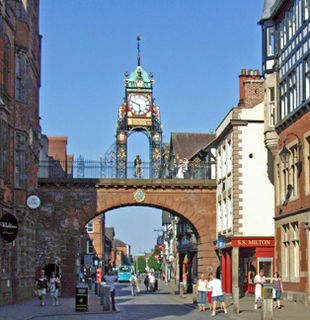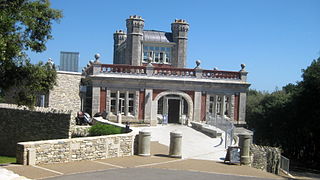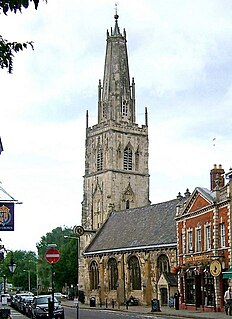
Swanage is a coastal town and civil parish in the south east of Dorset, England. It is at the eastern end of the Isle of Purbeck and one of its two towns, approximately 6+1⁄4 miles (10 km) south of Poole and 25 miles (40 km) east of Dorchester. In the 2011 census the civil parish had a population of 9,601. Nearby are Ballard Down and Old Harry Rocks, with Studland Bay and Poole Harbour to the north. Within the parish are Durlston Bay and Durlston Country Park to the south of the town. The parish also includes the areas of Herston, just to the west of the town, and Durlston, just to the south.

A pinnacle is an architectural ornament originally forming the cap or crown of a buttress or small turret, but afterwards used on parapets at the corners of towers and in many other situations. The pinnacle looks like a small spire. It was mainly used in Gothic architecture.

John Mowlem was an English stonemason, builder and founder of the quarrying and construction company "Mowlem, Burt and Freeman".

George Burt was a public-works contractor and businessman from Swanage, England, who managed the construction company Mowlem, founded by his uncle John Mowlem.

Eastgate, Chester is a permanently open gate through the Chester city walls, on the site of the original entrance to the Roman fortress of Deva Victrix in Chester, Cheshire, England. It is a prominent landmark in the city of Chester and the Eastgate clock on top of it is said to be the most photographed clock in England after Big Ben.

Swanage railway station is a railway station located in Swanage, on the Isle of Purbeck in the English county of Dorset. Originally the terminus of a London and South Western Railway (L&SWR) branch line from Wareham, the line and station were closed by British Rail in 1972. It has since reopened as a station on the Swanage Railway, a heritage railway that currently runs from Norden station just north of Corfe Castle to Swanage station. It now also runs to Wareham on certain services, but not on regular services due to signalling problems.

Bordeaux Cathedral, officially known as the Primatial Cathedral of St Andrew of Bordeaux, is a Roman Catholic church dedicated to Saint Andrew and located in Bordeaux, France. It is the seat of the Archbishop of Bordeaux.

The Butler County Courthouse is located in Hamilton, Ohio and was constructed from 1885–1889 by architect David W. Gibbs. The courthouse is a registered historic building listed in the National Register on June 22, 1981.

St. Mary's Catholic Church, also known as St. Mary of the Visitation Church, is a parish church of the Diocese of Davenport which is located in Iowa City, Iowa, United States. The church building and rectory were listed together on the National Register of Historic Places in 1980. They were both included as contributing properties in the Jefferson Street Historic District in 2004. The parish's first rectory, which is now a private home, is also listed on the National Register as St. Mary's Rectory. It is located a few blocks to the east of the present church location at 610 E. Jefferson St.

Durlston Castle stands within Durlston Country Park, a 1.13 square-kilometre (280-acre) country park and nature reserve stretching along the coastline south of Swanage, on the Isle of Purbeck in Dorset.

St Nicholas Church is a historic church in Westgate Street in the city of Gloucester, England, under the care of The Churches Conservation Trust. It is recorded in the National Heritage List for England as a designated Grade I listed building. Its truncated spire is a landmark in the city centre.

St Mary Magdalene's Church is located in Church Street, Clitheroe, Lancashire, England. It is the Anglican parish church of the town, and is in the deanery of Whalley, the archdeaconry of Blackburn, and the diocese of Blackburn. The church, dedicated to Jesus' companion Mary Magdalene, is recorded in the National Heritage List for England as a designated Grade II* listed building.

St Silas' Church is in Preston New Road, Blackburn, Lancashire, England. It is an active Anglican parish church in the deanery of Blackburn with Darwen, the archdeaconry of Blackburn, and the diocese of Blackburn. The church is recorded in the National Heritage List for England as a designated Grade II* listed building.

St James' Church is in Barry Street, Greenacres Moor, Oldham, Greater Manchester, England. It is an active Anglican parish church in the deanery of Oldham East, the archdeaconry of Rochdale, and the diocese of Manchester. The church is recorded in the National Heritage List for England as a designated Grade II listed building. It was a Commissioners' church, having received a grant towards its construction from the Church Building Commission.
St Mary's Cathedral was the cathedral of the Catholic bishop of Wellington, New Zealand for 47 years in the nineteenth century from its opening in 1851 until it was destroyed by fire in 1898. When the building reached its final form in 1867, St Mary's Cathedral was considered one of the finest, if not the finest, ecclesiastical structure in the colony. It was an important landmark in Wellington and its situation on Golder's Hill in Thorndon meant that it could be seen from many parts of the city and from points around the Wellington Harbour. Its beautiful, gilded statue of the Blessed Virgin Mary, high up on the tower, and the gilded crosses on its parapets, gables and tower were particularly admired features.

The Clock Tower is a Grade I listed belfry in St Albans, England which was constructed between 1403 and 1412, believed to have been completed in 1405. It has been claimed to be the only remaining medieval town belfry in England. Its construction has been seen as a protest against the power of the local abbey to regulate time-keeping in the town.

Stonequarry Creek railway viaduct is a heritage-listed railway viaduct over the Stonequarry Creek located on the Main Southern railway in the south-western Sydney town of Picton in the Wollondilly Shire local government area of New South Wales, Australia. It was designed by John Whitton as the Engineer-in-Chief for Railways and was built from 1863 to 1867 by Murnin and Brown. It is also known as Stonequarry Creek Railway Viaduct and Picton railway viaduct over Stonequarry Creek. The property is owned by RailCorp, an agency of the Government of New South Wales. It was added to the New South Wales State Heritage Register on 2 April 1999.

Swanage Town Hall is a municipal building on Swanage High Street in Dorset. Constructed by the local building contractor George Burt in 1882–83, it reused materials salvaged from demolition works in London. The façade was rescued from London's 17th-century Mercers' Hall and the external clock is dated to 1826. It was not universally welcomed and one critic in the 1930s described it as "positively dreadful". The hall serves as the chamber for the current town council and has previously hosted the magistrates' court, fire brigade and citizens' advice service.
There are many Grade II listed buildings in the county of Dorset. This is a list of them.
The Prince Albert Memorial is a memorial in Swanage, Dorset in the form of a stone obelisk to Prince Albert, the consort of Queen Victoria, who died in 1861. The memorial was erected in 1862, and is notable for having been the earliest civic memorial to the Prince. It was dismantled in 1971, and only rebuilt 50 years later, in 2021.



















